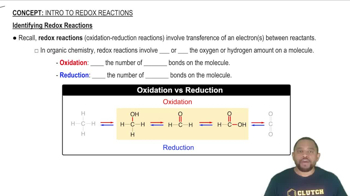A voltaic cell employs the following redox reaction: Sn2+(aq) + Mn(s) → Sn(s) + Mn2+(aq) Calculate the cell potential at 25 °C under each set of conditions. c. [Sn2+] = 2.00 M; [Mn2+] = 0.0100 M
Ch.19 - Electrochemistry
Chapter 19, Problem 74
A voltaic cell employs the redox reaction: 2 Fe3+(aq) + 3 Mg(s) → 2 Fe(s) + 3 Mg2+(aq). Calculate the cell potential at 25 °C under each set of conditions. a. standard conditions. b. [Fe3+] = 1.0 × 10^-3 M; [Mg2+] = 2.50 M. c. [Fe3+] = 2.00 M; [Mg2+] = 1.5 × 10^-3 M.
 Verified step by step guidance
Verified step by step guidance1
insert step 1: Identify the half-reactions and their standard reduction potentials.
insert step 2: Calculate the standard cell potential (E°cell) using the standard reduction potentials.
insert step 3: Use the Nernst equation to calculate the cell potential under non-standard conditions.
insert step 4: For part b, substitute the given concentrations into the Nernst equation and solve for the cell potential.
insert step 5: For part c, substitute the given concentrations into the Nernst equation and solve for the cell potential.
Key Concepts
Here are the essential concepts you must grasp in order to answer the question correctly.
Redox Reactions
Redox reactions involve the transfer of electrons between two species, where one species is oxidized (loses electrons) and the other is reduced (gains electrons). In the given reaction, Fe3+ is reduced to Fe, while Mg is oxidized to Mg2+. Understanding the oxidation states and the flow of electrons is crucial for analyzing the cell's operation.
Recommended video:
Guided course

Identifying Redox Reactions
Cell Potential (E°)
The cell potential, or electromotive force (EMF), is a measure of the voltage generated by a voltaic cell under specific conditions. It can be calculated using standard reduction potentials and the Nernst equation, which accounts for concentration changes. The standard cell potential is determined under standard conditions (1 M concentration, 1 atm pressure, and 25 °C).
Recommended video:
Guided course

Standard Cell Potential
Nernst Equation
The Nernst equation relates the cell potential to the concentrations of the reactants and products in a redox reaction. It is expressed as E = E° - (RT/nF) ln(Q), where Q is the reaction quotient. This equation allows for the calculation of cell potential under non-standard conditions, making it essential for solving parts b and c of the question.
Recommended video:
Guided course

The Nernst Equation
Related Practice
Textbook Question
Textbook Question
An electrochemical cell is based on these two half-reactions:
Ox: Pb(s) → Pb2+(aq, 0.10 M) + 2 e–
Red: MnO4–(aq, 1.50 M) + 4 H+(aq, 2.0 M) + 3 e– → MnO2(s) + 2 H2O(l)
Calculate the cell potential at 25 °C.
Textbook Question
An electrochemical cell is based on these two half-reactions:
Ox: Sn(s) → Sn2+(aq, 2.00 M) + 2 e–
Red: ClO2(g, 0.100 atm) + e– → ClO2–(aq, 2.00 M)
Calculate the cell potential at 25 °C.
Textbook Question
A voltaic cell consists of a Zn/Zn2+ half-cell and a Ni/Ni2+ half-cell at 25 °C. The initial concentrations of Ni2+ and Zn2+ are 1.50 M and 0.100 M, respectively. a. What is the initial cell potential?
